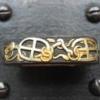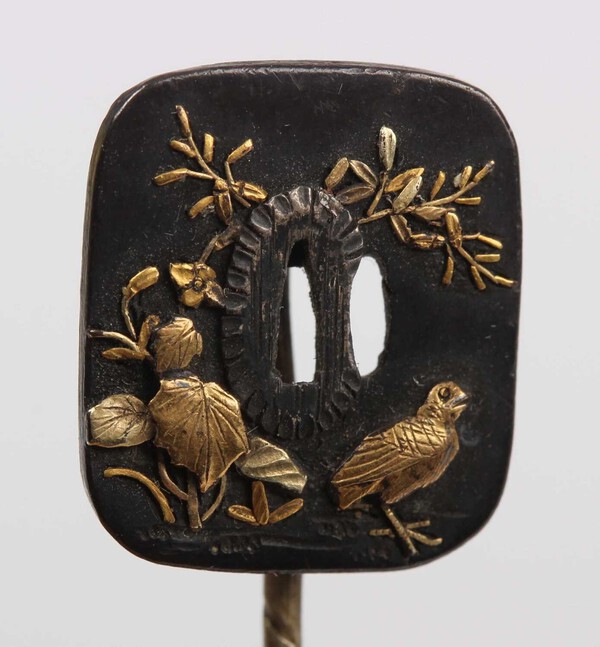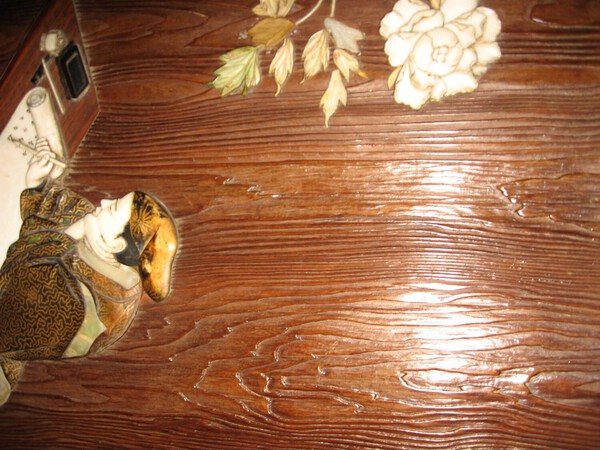-
Posts
198 -
Joined
-
Last visited
Everything posted by Davis
-
Thanks Mike for starting this off, I believe Mountbatten's actions saved many historic items from destruction. Many thanks John C. saved me from going through many old boxes. Thanks too, to John, I'd completely forgotten about that article. Regards the swords he acquired for himself ( B W Robinson ) Back in the early seventies I went to view an auction at Elliot and Snowden. It was a hot sunny day and propping open a door leading to the pavement was a leather clad gunto. A brown ticket label was attached to the hilt, on which was written "Brought back from Malaya, B W Robinson" There was no mistake it was his handwriting which was so very distinctive. On a quick search found this.
-
To-ken Society of GB monthly newsletter "Programme 81" gives an account of the talk given by Basil Robinson. He reminisces the time as a British army captain he sorted through 1800 surrendered swords in 1945. Mountbatten had access to all of these. "Programme No.37" has a letter from Han Bing Siong describing the sword at Windsor Castle and speculates on the sword Mountbatten returned to Japan. Unfortunately, I cannot lay my hands on these newsletters at the moment, perhaps someone has copies of them? Back in early postwar Britain Mountbatten wrote a memo listing those who were to be presented with swords but noted that they haven't arrived in the UK yet . I'm still searching for this. On the internet somewhere is a film clip of Mountbatten at his home, holding one of the swords surrendered to him, he talks at length on this. I'll look for it when I get time.. A gunto sword with a blade by Yasutsugu is on display at the Commando Training Centre and is presented annually. It is yet another one said to have belonged to Field Marshal Count Terauchi Hisaichi. It's known as the Mountbatten Sword. Quite a few pictures of this sword being presented at that establishment can be googled.
-
Great history, wonderful newsreel. The late Basil Robinson gave a talk to the To Ken many years ago and detailed how he was tasked together with a Japanese Officer to sort through and grade surrendered swords. Mountbatten returned to the UK with a very large number of these and made many presentations. I have some more details somewhere and will try and find my notes.
-
Dale, I'm not sure if this is relevant but I'll post anyway. It's from Japanische Schwertzieraten, which catalogues the Gustav Jacoby collection that was donated to a museum in Berlin. Published 1904.
-
Mike, Apparently she had twelve regiments. My guess and it is only a guess, Kings Own Scottish Borderers. 2nd Battalion went to Burma in 1943. Took part in Imphal and Battle of The Admin Box. The Royal West Kent Regimental Museum has exhibits from both these battles and from memory has that famous wooden cross with the names of the fallen. Mike, I can't help thinking that it would be a good project for your students to work on before presenting to a museum etc., As Brian said it could be sold at auction. The Stowe one ( from memory ) was sold at auction and fetched a very good price but it was hundreds of years older than the one you have. The information about the 2nd Battalion I found online, how accurate it is I don't know.
-
I can't read the brass plaque in full, google the Duchess of Gloucester and find what regiment she was Colonel in Chief to in 1948. Many schools had military items donated to them in the early fifties. Pubs, veteran's clubs and other institutions displayed them with pride. Stowe school had a superb tachi which as far as I can remember now, came up at Phillips. I was called to a local school years ago as the headmaster wanted to know what to do with two antique Indian swords that had been donated.. Considering the world we live in now the best thing would be if the school donates the sword to the Regimental Museum. it's a part of history, and should be remembered.
-
Thanks Colin, appreciate you comments, Lewis and Russ, nice to know you remember those times. Alex, I was going to try and reply with something positive and mention the good work that was done in 2007 when they were trying an outright ban. I spent much time writing to MP's and Home Office etc., It was others though who managed to save the situation. See this page from the Consultation Document. I just broke off for a cup of tea and saw a news item on TV, an incident is in progress at Hainault tube station ( I knew it well ). A man has gone berserk with a sword and stabbed five people. The shape of the sword is familiar. Seeing that, my attempts at being positive have evaporated. I don't recognize my country anymore, the sacrifices by my parents and grandparent's and those generations, were in vain. Consultation document.pdf
-
Brian, I think you might be right. I remember those early London Arms fairs. Long queues formed up early before the opening, once in, the place would be buzzing, with much jostling around the dealers tables. I went to one awhile ago and there were more dealers than punters. I've collected for many years and have noticed how social attitudes have changed. I grew up postwar in a badly bomb damaged area of the East End of London. As a seven year old boy I took part of my collection to school. A spear, picklehaube and a German pistol. The helmet was put on display in the school library, the spear wouldn't fit in the glass cabinet and I had to take it home again. The gun was more of a problem and my mother had to go to the school to pick it up. As a teenager I would advertise in a weekly magazine called the "Exchange and Mart". It was a different world then and very trusting. Virtually all communication was by letter and people would send me things by post, usually wrapped in a single sheet of brown paper tied with string. I made a return offer by post and if the offer was accepted send a postal order to them, if not I would return the item using the same brown paper. I bought my first Japanese sword through the Exchange and Mart,. from a police officer. I went to his home, gave him a couple of quid and travelled home with it on the bus. Other passengers weren't the least bit bothered or interested. It was fun collecting back then, how times have changed.
-
-
-
Two puzzles solved in less than a week. I would never have found that information. Thank you very much Piers. Brilliant.
-
Thanks Piers. On this subject, my books, like my knowledge are very rudimentary. The information you've provided is new to me and very welcome. It would be interesting to see your carving.
-
I just can't get a good picture today. I've tried to read it but can't. If possible Piers could you Romanize it as I have some books listing artists in that way.
-
There is Piers, although I can't read it, perhaps you can help again? I'll try and get a decent photo.
-
Thanks, pins it down even more. Agree with remarks re blade quality. What puzzled me was the description of this lot which was in a specialised sale. Dagger, not sure whether bone or ivory, staghorn not considered. These are some damaged ivory and a small bone section that I have. They were of very little value but are now virtually worthless following the recent legislation. I think some skill was needed to put the character into the little mans face, two inches tall.
-
Thanks Piers, I thought you might provide the answer. I agree with you both, even at a quick glance, staghorn. Interestingly this was at a sale of "Oriental Works of Art" at a very good auction house
-
I acquired this years ago and still don't have a clue what the pursuits are, random carvings of everyday life or is there a story being told? Anyone have any ideas?
-
Top row, third right was used as a template for the cupboard below. There were another six tsuba in a drawer. One of these was carp and waterfall, which was used as the other template. All were covered in a protective barrier of grime and nicotine. Unfortunately I don't have the top section or the tsuba.
-
-
I once owned two tanto that were almost identical to yours. Also over the years I have encountered a good number of others, very similar, almost generic. I've concluded probably wrongly, that they were produced and put together in large numbers in a specific region during a very narrow time frame, (Meiji)? With all the examples I've seen the hilts were beautifully wrapped and always very well preserved, perhaps indicative of age?
-

Is this sword tag important or just an add on?
Davis replied to 1960katana's topic in General Nihonto Related Discussion
Back in the 80's I remember that a privately ran military museum closed and consigned it's entire contents to auction. One of the lots was a sword with a brass plaque attached stating that it had been surrendered on the Missouri. Whether this was authentic I don't know and I no longer have details of that auction. Some senior officers did acquire batches of swords and distribute them. Lord Mountbatten was one such. Pre WW2 he had visited Japan with the then Prince of Wales and was known to have some knowledge of swords. At wars end he acquired many hundreds of the best surrendered swords. It seemed he enjoyed presenting them both officially and informally. Many were fitted with good quality silver plaques screwed to the saya and inscribed with the recipients name. Basil Robinson, then a British Army Officer, together with a Japanese Officer were assigned the task of grading some of these swords. -

Peter Yorke RIP.
Davis replied to charlesf's topic in Sword Shows, Events, Community News and Legislation Issues
Was Peter a member of the board? I believe that he was but not under his real name. Either that or someone contributed to discussions on his behalf. -
-

Peter Yorke RIP.
Davis replied to charlesf's topic in Sword Shows, Events, Community News and Legislation Issues
Just seen this. I knew Peter from the late sixties onwards. In those days his trademarks were his old sheepskin jacket and his jet black hair worn in an unusual fashion. He seemed to be at every auction I ever attended, from the very best in London to the local scout hut in the middle of nowhere. He came to my home several times over the years and I sold him a number of swords. His love of swords was only exceeded by his love for his dogs. My wife and I visited him one Sunday, between showing me his swords he was busy cooking a huge roast chicken for them. I couldn't help but notice that they were well overfed. We didn't always see eye to eye but I found him a most interesting person. -
Nearly 40 years ago I wrote to Manfred Rommel to ask him if he knew what had happened to his father's Japanese sword. In a friendly reply he told me that it had been looted along with other items by American troops in 1945. Regards Rommel's gallantry awards, they were kept in a vault and verified as such by British author David Irving. Rommel's caravan was and still might be in the Imperial War Museum. In which was displayed a portrait photograph of Rommel, placed there by Bernard Montgomery. Apparently Montgomery put the caravan to good use and used it himself for the duration of the war. Mick



















